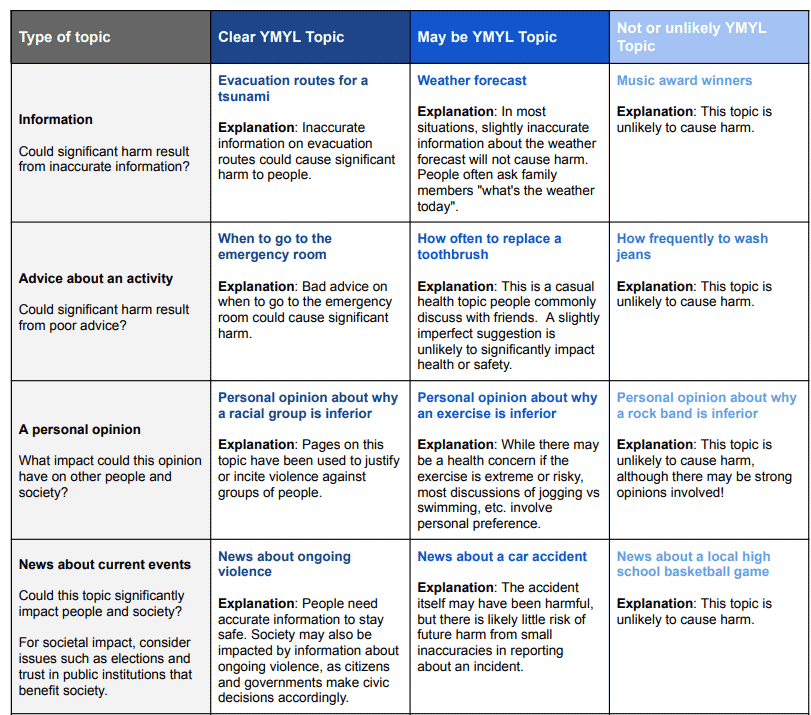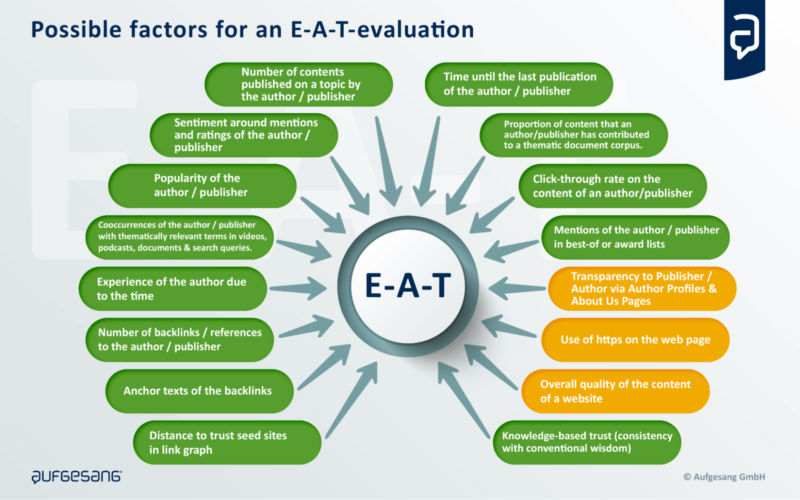It’s never been easier to share our opinions online—accurate or not.
As a measure against dishonest or inaccurate information, Google wants to serve users trustworthy search results from authoritative sources who are experts in the subject matter.
Why?
Because in the absence of reputable, authoritative search results, misinformation floods the web, impacting unsuspecting and often vulnerable readers.
Google employs a team of Quality Raters (humans, not bots) to assess website content in order to train algorithms to serve more credible results.
So, broadly speaking, they are looking to assess the quality of content as outlined in the guidelines.
“The level of E-A-T needed depends on the purpose and topic of the page. For some types of pages, formal expertise may not be needed. For pages on YMYL topics, it is critical. Consider the purpose and the topic of the page. What is the risk of harm? Is there a need for high E-A-T to prevent harm? If so, even mild inaccuracies may cause informational pages on YMYL topics to be untrustworthy.”
What are the Google Quality Raters Guidelines and E-A-T?
Let’s look into each of the three terms (Expertise, Authority, and Trust) to get an understanding of what they mean.
Expertise
When reviewing a piece of content, raters look for how well it has communicated the author’s expertise.
About YMYL sites, the guidelines seek formal expertise in particular:
“Formal expertise is important for YMYL topics such as medical, financial, or legal advice.”
Pro tip: Interviews with experts are a great way to incorporate expertise into your content if you are not certified or authorized to speak about a subject matter.
Authoritativeness
The focus here is on the author’s reputation, and specifically, what other experts and influencers are saying about them online.
While customer reviews are often attributed to reputation, it’s less relevant for websites considered YMYL. In this instance, you should look for positive testimonials from peers.
“YMYL reputation should be based on evidence from experts, professional societies, awards, etc.”
Trustworthiness
Google asks its quality raters to look for several factors to establish trustworthiness. These factors include the accuracy of the content, whether you reference sources or not, and whether you include your contact details.
The guidelines reference many examples, including this one for the Cleveland Clinic, which suggest to raters they should look to other trustworthy sources.
“According to Wikipedia, the Cleveland Clinic ‘is currently regarded as one of the top 4 hospitals in the United States” which can be confirmed by reputable news articles cited in the references section. Users can trust medical information on this website.”
E-A-T and Your Money or Your Life (YMYL) Content
We look to the Internet for many things—shopping, recipes, weather—but there is a specific type of content that Google takes note of “Your Money or Your Life” (YMYL) content refers to web content and blogs that ‘have a high risk of harm because content about these topics could significantly impact the health, financial stability, or safety of people, or the welfare or well-being of society’.
In a world flooded with well-intended guidance, it’s critical to ensure your YMYL content is useful and factual.
That’s because Google supports high-quality, expert-led content that is moderated and beneficial to your readers, over content that could negatively impact their financial status, health, safety, legal standing, and overall wellbeing.
YMYL content is directly addressed in Google’s Quality Rater Guidelines, relating to Expertise, Authoritativeness, and Trustworthiness, widely known as E-A-T. When crafting your website content, you want to incorporate E-A-T in every piece of content you create, whether it’s an interview, a survey, a list, or an informational blog post.

Source: Google’s Quality Rater Guidelines
7 Great Ways to Improve E-A-T For Your Content Strategy
Disclaimer: These tips have not been published by Google. This advice is based on interpretations of the guidelines, findings from industry peers, and personal experience.
1. Author Bio
Include an author bio that clearly communicates the author’s education, experience, and reputation.
2. Author Page/s
If you have a roster of authors regularly contributing to your content, consider individual author pages or a page dedicated to your expert contributors.
On these dedicated pages, you can go into more detail about their expertise, authoritativeness, and trustworthiness.
3. Subject Matter Experts
Only use subject matter experts as authors. Personally, I like to Google the author’s name in another tab and check other search results to verify their expertise.
4. Peer-Reviewed
No matter your industry, you should benefit from having each blog post peer-reviewed by an expert, or at least an expert whose authority is more evident than your own.
5. Cite Your Sources
Reference authoritative sources, particularly for YMYL content with government, financial, safety, legal, and other advice.
6. Editorial Policies
Publish an editorial policy. Discuss what you aim to do with your content and how you select your contributors/authors. Equally important is to provide a channel for readers to contact you with content feedback.
What else can I do to improve my website’s E-A-T?
My tips have been specific to improving the content you produce, but there are many ways you can improve your website in general.
Stanford University researchers looked at how to establish web credibility, the results of which are published in the Stanford Guidelines for Web Credibility.
There are a few tips worth noting:
- Show that there’s a real organization behind your site.
- Make it easy to contact you.
- Design your site so it looks professional
- Make your site easy to use — and useful.
- Use restraint with any promotional content
- Avoid errors of all types, no matter how small they seem.
As a side note, you may find it interesting to know that the co-founders of Google, Larry Page and Sergey Brin, both attended Stanford. So, too did Google’s current CEO, Sundar Pichai.

What can you expect from demonstrating E-A-T?
Beyond gaining your readers’ trust and offering them a better experience on your site, your investment in following the guidelines should improve your search performance.
SEO software company Sistrix analysed 250 domains to identify the big winners and losers in search in 2021. They made a significant observation:
“One of the most clear patterns from 2021 has been the increasing rise in visibility among government websites, as well as highly-trusted medical authorities who demonstrate significant E-A-T (expertise, authoritativeness and trustworthiness).”
Example 1: Government Website
One winning example noted by Sistrix as a strong performer in 2021 was the Victorian government’s health site Betterhealth.vic.gov.au.
From 1st April 2021 to 1st March 2022, Sistrix determined that Better Health’s absolute visibility in Google increased a whopping 188.7%.
Given it was an Aussie site, I took a deeper look at how well Better Health performed in search in the United States. I used SEMRush to analyse the site’s search performance.
There are some important points to highlight:
- A 41.2% increase in search terms between April 2021 to March 2022; 1.7 million search terms to 2.4 million search terms
- An estimated increase of 44.1% in organic traffic
- A 41.6% increase in Traffic Cost* from $3.6M to $5.1M
* Traffic Cost is a metric by SEMRush to demonstrate the value of the search term’s ranking. Essentially, the traffic cost is what they estimate a competitor would have to spend in Google Ads to replicate the same exposure.
The interesting point was that here in Australia, the improvement was not as strong. The estimated traffic cost increased from $2.9M to $3M. To compare, the estimated organic traffic in Australia dropped from 2.9M to 2.6M.
How could we explain such a strong increase for the site in the United States, whilst traffic dropped in Australia? I have to assume that here in Australia Better Health was already close to the Total Addressable Market with little room (search volume) to grow.
Example 2: Legal Help Website
Another winning example was Lawinsider.com. Sistrix discovered that Law Insider’s absolute visibility in Google during the same period increased by 187.2%. I used SEMRush again to investigate further:
- A 226% increase in Google’s top 10 rankings between April 2021 to 2022; 58,858 search terms to 192,015 search terms
- An estimated increase of 272% in organic traffic
- A 364% increase in Traffic Cost* from $559.6K to $2.6M
Final Takeaway
With increasing demand on Google to rank trustworthy content, it’s critical to demonstrate to your readers that you are producing trustworthy content.
The verdict: Don’t ignore the Quality Raters Guidelines, and use them as a valuable tool to help shape your content strategy.
In the spirit of this post, let me leave you with the words of John Mueller from Google:
“My recommendation would really be to go and look at the quality rater guidelines and really go through that and think about it more with the perspective of if a quality rater were looking at your site, or at the general area where your site is active in, like some of your competitors as well, how they might respond to review requests there.”

